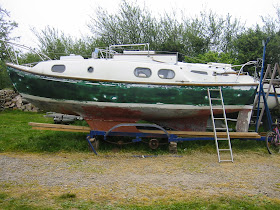People who renovate old boats are dreamers, romantics and
often, escapists. That’s fine – I openly admit to being all three. As a writer
they are valuable assets, necessary almost, but when it comes to renovating an
old boat their use is strictly limited. Dreams are good motivators. The
‘romance’ of the sea, the escape from the boring, mundane everyday existence,
provides the reason for our investment of time and money in such projects.
Beyond that however, these traits become something else,
something almost dangerous. They convince us to take up lost causes; they
assure us that the investment is worthwhile, that all will come out right in
the end, and worst of all, they make us overlook our own inadequacies. We begin
to believe that we are capable of achieving the impossible. People like us
don’t see rotting derelict hulks, flaking paint and dripping rusty iron – oh
no, we see ‘potential’.
There are many waypoints along the road from ‘Dreamland’ to
the land of ‘Achievement’ – places with names such as frustration, ignorance,
lack of resources, incapability and over-investment. It’s a long road, longer
than you think, and dreams don’t last forever. At some point, you have to let
reality in. Most of us do this far too late.
So the advice? Open your eyes take a deep breath and ask
yourself if you can really do this:
put down that book about blue
water voyaging and pick up a practical text on how to rewire 12 volt system;
check out the cost of tools
you’ll need – then double it;
estimate the cost of the
materials you’ll need – then double it;
consider the amount of time
you’ll need – then double it.
 By way of example here is my experience of boat renovation.
My boat is a Westerly Nomad, 23ft in length, built in 1967. Sanding, cleaning,
painting, polishing the GRP exterior, rebuilding the hatches, and installing a
new electrical system took eighteen months. I was fortunate in that I didn’t
have a day-job or young children to distract me. When I say eighteen months – I’m
talking, on average, three days a week. In winter I couldn’t feel my fingers
and in spring I was eaten alive by mosquitoes.
By way of example here is my experience of boat renovation.
My boat is a Westerly Nomad, 23ft in length, built in 1967. Sanding, cleaning,
painting, polishing the GRP exterior, rebuilding the hatches, and installing a
new electrical system took eighteen months. I was fortunate in that I didn’t
have a day-job or young children to distract me. When I say eighteen months – I’m
talking, on average, three days a week. In winter I couldn’t feel my fingers
and in spring I was eaten alive by mosquitoes.
I launched at the end of last summer and the cabin was like
a slum. This year I have been working on that interior, eating wood and paint
dust despite the face-mask. I hope to finish by mid-summer (or I won’t finish at
all because it will be too hot to work or paint in there by then) and then –
guess what? The exterior wood will need re-varnishing and she’ll need a
haul-out for anti-fouling. There is a term for a job that never ends but I can’t
remember it and I’m too weary to look it up.
So there is the advice – stop dreaming and start thinking
practically now. But you won’t of course. You’re a dreamer, a romantic and an
escapist – and without you – these old boats wouldn’t have a chance.
Seaward




